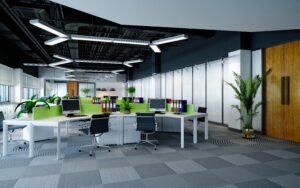
One of the most significant challenges businesses have faced in the last six months is attracting and retaining talent, trying to find winning ways to entice employees back into the office environment.
Since the Pandemic, a large proportion of the workforce has been working at home and become accustomed to it. What was once the exception has now become the norm, and companies are expected to respond positively to this change, offering hybrid solutions where possible.
However, as Christian Mabey, Managing Director, Optima Products explains that is just the tip of the iceberg. Staff are also increasingly concerned with how their employer is actively getting involved in the collective effort to reduce the global carbon footprint. It’s rapidly becoming another important workforce requirement employers need to consider beyond the baseline provision of a comfortable working environment.
This situation has led to the realisation, for many companies nationwide, they can take nothing for granted when it comes to recruitment and must respond directly to evolving employee needs.
So, with businesses looking to enhance their proposition, remaining relevant in an ESG-led landscape as well as achieving best value, my suggestion is they look to their office space, weaving sustainability into every possible part of the workplace.
Realising value in sustainable design
It’s a misconception that sustainable design is prohibitively expensive. In the past, business owners have favoured the solution with the lowest upfront price tag, without considering the more sustainable option which, although more expensive upfront, might be the most effective option long-term. A good example would be single-use plasterboard drywall vs. circular-manufactured aluminium framed glass partitions.
It’s also wrong to think sustainable design lacks visual appeal. We’ve come a long way aesthetically, and office fit-out specialists and their clients now appreciate the importance of creating functional spaces which also deliver style, sophistication, and comfort sustainably.
For example, office refits maximise on what’s already there. For example, instead of discarding existing office furniture, it’s worth considering how it can be given a new lease of life.
If these items are still in good condition and functional, there’s really no excuse to throw them away. So, it’s essential they’re given a second life while prioritising natural materials over synthetics and plastics, particularly when looking to renovate, refresh or reupholster any existing elements.
The rise of Circular Systems
Further, adopting a systems-based approach can enhance a sustainably specified commercial space. For example, opportunities exist to reduce utility bills by designing offices incorporating elements of smart automation within HVAC and window systems, to capitalise on fresh air and natural sunlight.
Approaching the project with a full lifecycle approach also helps, following the now universally appreciated mantra of the ‘Circular Rs’. Fundamentally, creating a sustainable space that will outlast the incumbent occupier means one which is delivering the full value of the component originally chosen.
Equally, premium products and materials will have longer lifespans, meaning they can be reused multiple times before even considering recycling. This maintains the desired degree of style, whilst achieving the substance of a robust, high-performance interior, reducing the frequency and cost of refit.
Wellbeing in mind
Beyond reducing environmental impact, there are countless other benefits to consider when designing a sustainable office space. The most significant is employee wellbeing or, in other words, workforce sustainability.
The past two years have taught us one very important lesson: people are a finite and precious resource that should never be exploited or depleted. A sustainable workforce goes beyond hiring people with the right skills, it’s about nurturing long-term growth and engagement.
Therefore, a well-thought-out office space is adapted to its team’s evolving needs and provides a good balance of areas designated for various types of work, from collaboration to highly focused individual tasks.
The number of virtual meetings isn’t going to decline any time soon, so it’s essential to provide private, distraction-free areas for employees to conduct calls. Considering the direct impact sound levels have on comfort and mental health, it is worth investing in proper acoustics during design. Using high-performance glass partitions can help maintain privacy, whilst still ensuring an open, light, and airy environment.
Additionally, biophilic design has been found to enhance cognitive function as well as physical and mental health, ultimately benefiting the wellbeing, creativity, and productivity of employees. The principles of biophilia can be applied in many ways beyond foliage and natural finishes to create a cost-effective office environment. A great way to achieve this is to design an open-plan space that takes full advantage of natural light and temperature fluctuations.
The empathetic office
Of course, some of these examples may seem trivial, but as the average worker spends most of their waking hours in the office throughout their career, creating a space with sustainability and wellbeing in mind is paramount.
It’s time to rethink the spaces we work in, prioritising solutions that are designed to evolve as we change and grow. Ultimately, there’s more to sustainable design than reaching net-zero goals, it’s about understanding what truly matters to the people who utilise the space and aligning with their values to create a harmonious environment.
Read more:
Designing the modern workplace with sustainability in mind





